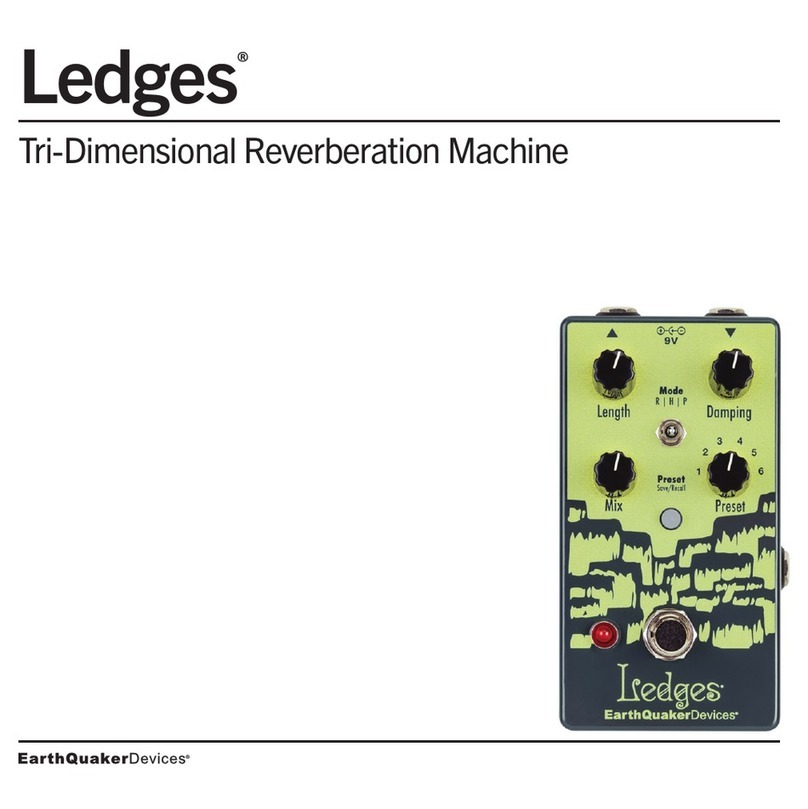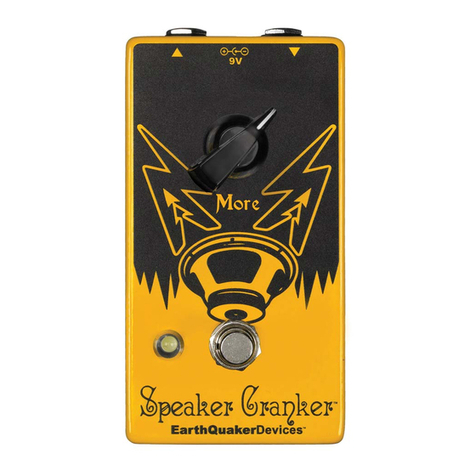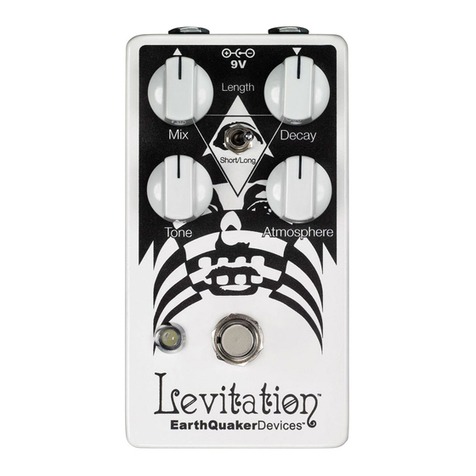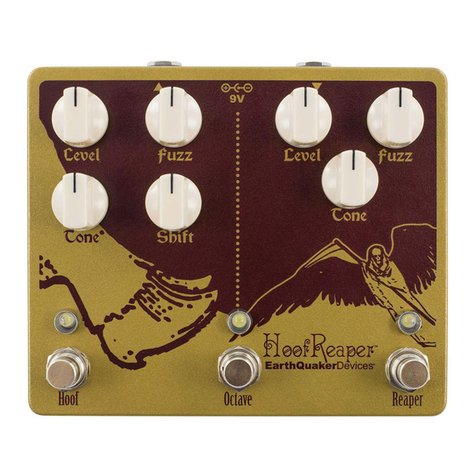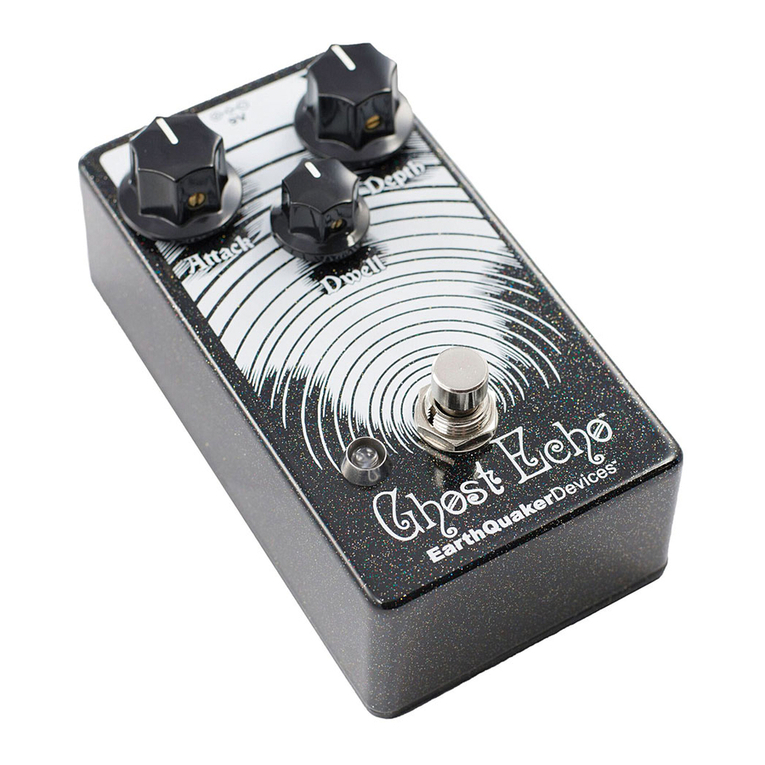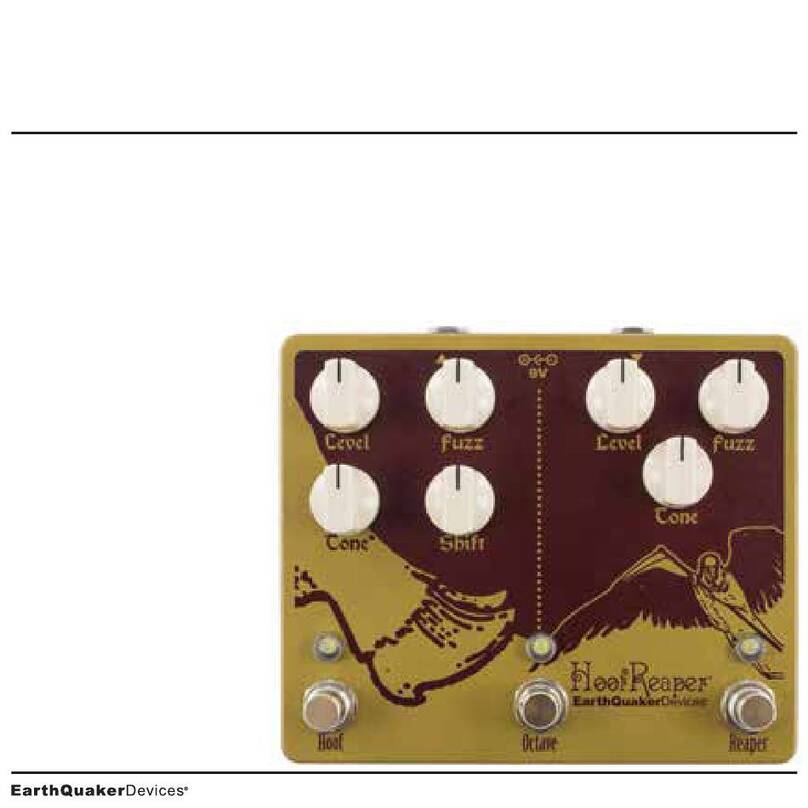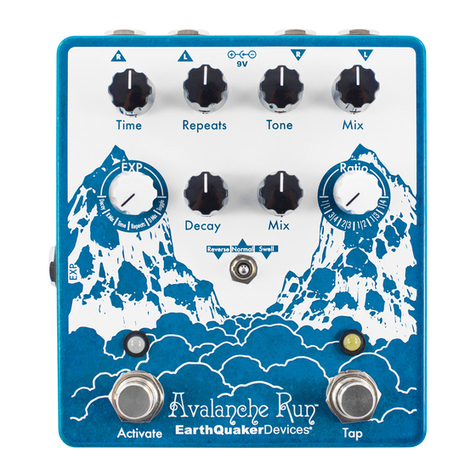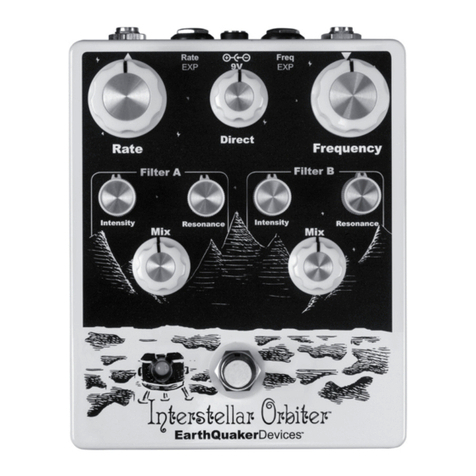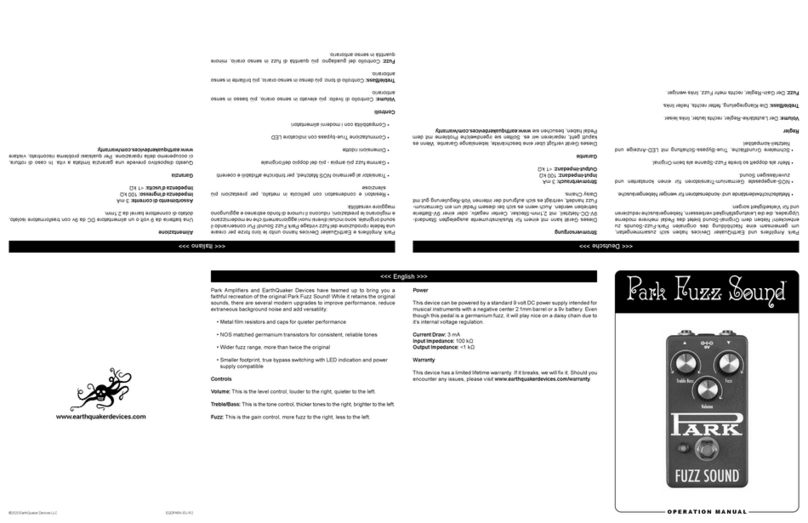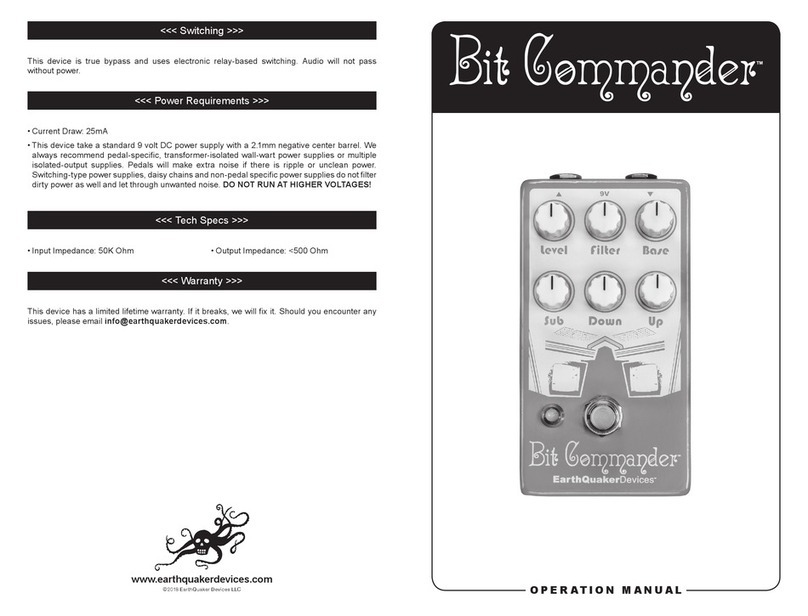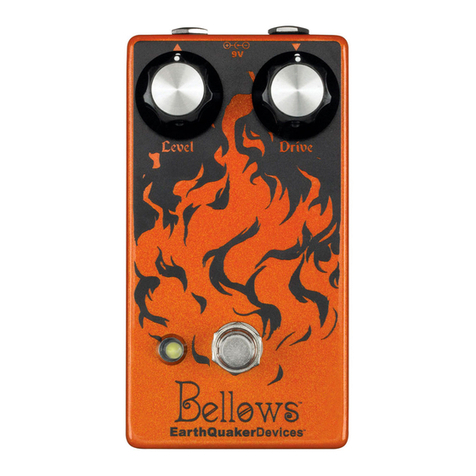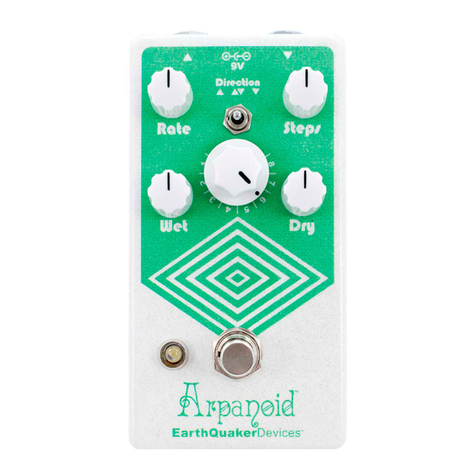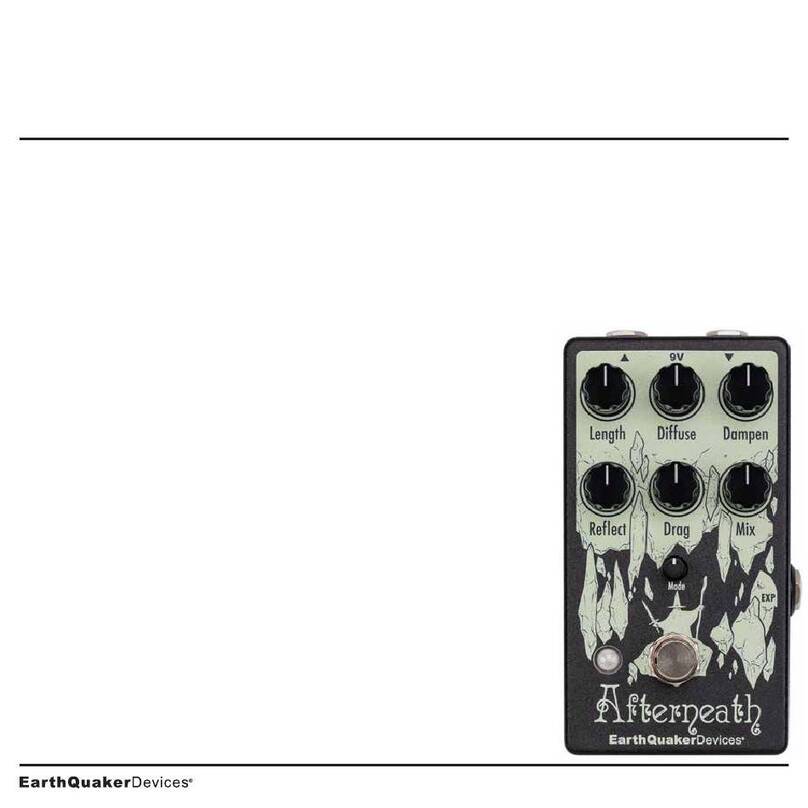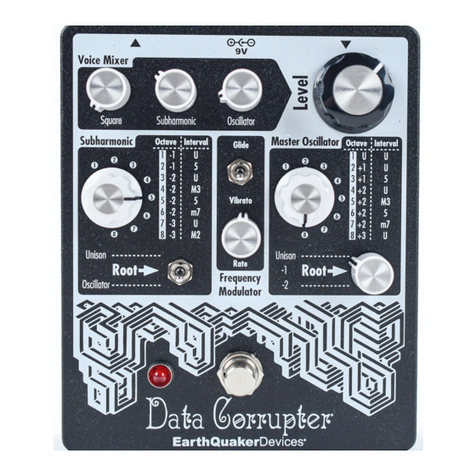<<< English >>>
Welcome to your new Afterneath otherworldly
reverberation machine from EarthQuaker Devices®
brand effects pedals! The Afterneath sounds a lot like
it looks – a wizard bursting forth from ethereal cave
and ready for the ambient battle. You are the wizard
– or sorceress, if you prefer – and the cave is your
instrument’s signal, vast, expansive, and magical. Do
you go inside? Roll a D20 to proceed!
Once inside, a reection of light from an unknown
source catches your eye, and you notice a bizarre sheen
on the walls of the cave. You timidly inch closer to the
walls of the cave. Placing your hand gently on the cavern
wall, you feel the rock move. The cave is alive! Alarmed,
you emit a loud gasp, which reverberates throughout
the subterranean landscape. Upon further listening,
it appears as though the reverberations of your voice
are in fact a swarm of short digital delays which may be
used to create wild and cavernous reverbs, or scattered,
short, rhythmic delays with bizarre characteristics.
Take a moment to consider your Intelligence and Wisdom
scores, as well as your spell inventory before proceeding
further. You have seven spells at your disposal…
Will you cast “Length,” which controls the decay length
of the reverb?
What about “Diffuse,” which adjusts the spread of
the reverb? With your wand (or just the knob) turned
counterclockwise, the reverb is sharper with more
attack, resulting in a stuttering sputter of individual early
reections. Clockwise casts a washy, more ambient-
sounding hex.
Overwhelmed by fear, you hastily cast “Dampen!” As you
shout the incantation, you notice that a counterclockwise
variation of this spell results in brighter tones, while as
you rotate your wand clockwise; you hear darker tones
with a mellower top-end. It’s almost as if your magic
changes the hardness of the cavern walls, and thus the
tonal characteristics of the reverb!
Elsewhere in your book of magic is “Drag,” which
separates the individual digital delay lines, literally
dragging them through the very fabric of time and space
towards an unknown event horizon from which they may
never return. Clockwise “Drag” positions will gather the
delay lines close together for a more reverb-like effect.
Turn the “Drag” counterclockwise, and the delay lines will
begin to pull apart for a scattered ping-pong delay effect.
The Drag can be put under voltage or expression
control using the “EXP” jack located on the side and
operates in 9 different modes which are selected by the
small “Mode” control. These modes are: Unquantized,
Unquantized with slew, Unquantized volt/octave,
Chromatic scale, Major scale, Minor scale, Pentatonic
scale, Octaves & fths and Octaves. These modes
drastically change the way the Drag control functions,
especially while using an expression control or CV.
The “Reect” alters the depth of the cave, and with it
the regeneration of the reverb. This acts as a feedback
control and will self-oscillate if cast by a high-level
user. Turn clockwise for more wash and echoes,
counterclockwise for less.
Finally, the “Mix” alters the alchemical balance between
the input signal and the effect. The Afterneath does not
go fully wet but does lower the level of the input signal
as you raise this control to create the appearance of a
fully wet reverb.
The Afterneath features a completely analog dry signal
path, totally digital delay path, buffered bypass with
Flexi-Switch®Technology and a tails/no tails option on
bypass. Each and every Afterneath is built by a mix of
robots and human beans in the torch-lit cave community
of Akron, Ohio.
Modes
The Modes control changes the way the Drag control
functions. The LED will change colors indicating which
mode you are in.
1. Unquantized: Smooth, unquantized response over
the operating range
2. Unquantized with Slew: Smooth, unquantized
response over the entire operating range, but with
a musical slew that is reminiscent of turning the
varispeed knob on a vintage British tape delay. The
“Drag” will lag behind the knob or cv changes, but
then quickly catch up.
3. Unquantized Volt/Octave: Smooth and unquantized,
yet scaled to align with the 1v/octave curve to allow
melodic modulation of audio in the buffer, or control
the frequency of self-oscillation like a voltage
controlled oscillator.
4. Chromatic Scale: Quantized 1v/octave to the
chromatic scale
5. Minor Scale: Quantized 1v/octave to the minor scale
6. Major Scale (Lydian): Quantized 1v/octave to the
major scale (Lydian)
7. Pentatonic Scale: Quantized 1v/octave to the
pentatonic scale
8. Octaves & Fifths: Quantized 1v/octave to omit all but
octaves and fths
9. Octaves: Quantized 1v/octave to omit all but octaves
Expression Jack
This is an expression pedal control jack for the Drag. The
Afterneath requires an expression pedal with a value of 50k,
we recommend the Moog EP-3 or similar. While it will work
with a standard 10K expression pedal, a 50K expression
pedal will allow you to access the full range of each mode.
• Tip is the wiper, Ring is 5v and Sleeve is ground.
• You can also use CV with this jack. CV operates 0-5v.
Flexi-Switch®Technology
This device features Flexi-Switch Technology! This
electronic switching style allows you to simultaneously
use momentary and latching style switching.
• For standard latching operation, tap the footswitch
once to activate the effect and then tap again to
bypass.
• For momentary operation, hold the footswitch down
for as long as you’d like to use the effect. Once you
release the switch, the effect will be bypassed.
The Afterneath uses electronic buffered bypass, it
requires power to pass signal and the buffer is always
active. You may experience a pop the rst time the
Afterneath is switched on after power up.
Tails/No Tails Switching
The Afterneath is factory set in “tails mode.” This means
that the wet signal will naturally decay and slowly fade to
silence after the effect is switched off.
To deactivate this feature:
• Unplug the power cable from the power jack.
• Hold down the footswitch and insert the power cable.
• The LED will ash 3 times. You can now release the
footswitch.
Follow the same steps to reactive tails mode.
Power Requirements
This device takes a standard 9 volt DC power supply with
a 2.1mm negative center barrel. We always recommend
pedal-specic, transformer-isolated wall-wart power
supplies or multiple isolated-output supplies. Pedals
will make extra noise if there is ripple or unclean power.
Switching-type power supplies, daisy chains and non-
pedal specic power supplies do not lter dirty power as
well and let through unwanted noise. DO NOT RUN AT
HIGHER VOLTAGES!
Current Draw: 100 mA
Input Impedance: 1 MΩ
Output Impedance: 500 Ω
Warranty
This device has a limited lifetime warranty. If it breaks,
we will x it. Should you encounter any issues, please
visit www.earthquakerdevices.com/warranty.
<<< Deutsche >>>
Willkommen beim Afterneath – einem Reverb von
EarthQuaker Devices®, das nicht von dieser Welt ist! Das
Afterneath klingt so, wie es aussieht: Dies ist ein Sound-
Zauberer, der eine verborgene Höhle betritt und sich furchtlos
in die Ambient-Schlacht wirft. Sie sind dieser Zauberer (m/w/d/
körperlos) – und die Höhle ist das riesige, ausladende und
magische Signal Ihres Instruments. Werden Sie eintreten?
Zeit, sich zu entscheiden!
Nachdem sich Ihre Augen an das Dunkel gewöhnt haben,
bemerken Sie einen Lichtreex – es lässt sich nicht sagen,
wo die Quelle ist. Aber die Reexe erleuchten die Höhle
in geisterhaftem Licht. Vorsichtig nähern Sie sich den
Höhlenwänden. Sie legen Ihre Hand auf das kühle Gestein
– und spüren, wie es sich bewegt. Die Höhle lebt! Sie stoßen
einen überraschten Ruf aus, der in der unterirdischen
Landschaft widerhallt. Ihr Gehör ist nun geschärft. Sie ahnen,
dass der Nachhall Ihrer eigenen Stimme in Wirklichkeit ein
geisterhafter Schwarm kurzer digitaler Delays ist, die Sie sich
durchaus nutzbar machen könnten – um wilde, verschlungene
Halleffekte oder Staccato-artige, rhythmische Wiederholungen
mit wahrhaft bizarren Eigenschaften zu erzeugen.
Nun gilt es! Sie müssen Ihre magische Intelligenz, Ihre
alchemistische Weisheit und Ihr Zaubersprüche-Repertoire
prüfen, bevor Sie den nächsten Schritt wagen. Sieben
Zaubersprüche stehen Ihnen zu Gebote.
Wollen Sie es mit „Length“ versuchen, um die Ausklingzeit des
Reverbs zu steuern?
Wie wäre es mit „Diffuse“, um die Streuung des Nachhalls
zu steuern? Wenn Sie Ihren Zauberstab (oder einfach den
„Diffuse“-Drehregler) gegen den Uhrzeigersinn drehen,
wird der Klang des Halls aggressiver, und das Einsetzen der
einzelnen Wiederholungen wird deutlicher hörbar, sodass der
Effekt eher wie eine Kaskade einzelner Reexionen klingt.
Wenn Sie den Regler im Uhrzeigersinn drehen, wirkt der Klang
weicher und verwaschener.
Aber Sie haben noch einen Zauberspruch im Köcher:
„Dampen!“ Die Magie wirkt. Beim Drehen gegen den
Uhrzeigersinn wird der Klang heller. Bewegungen im
Uhrzeigersinn wiederum scheinen eine beruhigende Wirkung
zu haben; alles wird weicher und dunkler. Fast scheint es, als
ob Ihr Zauber die Oberächenstruktur der Höhle und damit
ihre klanglichen Eigenschaften verändert!
An einer anderen Stelle in Ihrem Zauberbuch nden Sie
„Drag“ – einen Zauberspruch, der die digitalen Delaygruppen
voneinander trennt und sie in die fernsten Ecken des
Raum-Zeit-Gewebes treibt, aus denen sie möglicherweise
nie mehr zurückkehren werden. Wenn Sie „Drag“ im
Uhrzeigersinn bewegen, rücken die Delays aneinander,
sodass ein hallähnlicher Effekt entsteht. Wenn Sie „Drag“
gegen den Uhrzeigersinn drehen, werden die Delays
auseinandergezogen, sodass statt eines Halls verstreute
Ping-Pong-Effekte zu hören sind.
Drag kann auch von außen gesteuert werden. Dazu schließen
Sie ein Expression-Pedal oder eine Steuerspannungs-
Quelle an die seitliche „EXP“-Buchse an. Hier stehen neun
verschiedene Modi zur Verfügung, zwischen denen Sie mit
dem kleinen „Mode“ -Regler wechseln können. Diese Modi
sind: Nicht quantisiert, Nicht quantisiert mit „Dreh“, Nicht
quantisiert, Volt/Oktave, Chromatische Skala, Dur-Tonleiter,
Moll-Tonleiter, Pentatonische Skala, Oktaven & Quinten sowie
Oktaven. Diese Modi ändern die Funktionsweise des Drag-
Reglers drastisch – dies gilt insbesondere bei der Verwendung
eines Expression-Pedals oder einer Steuerspannung.
„Reect“ verändert die „Tiefe der Höhle“ – oder profaner
formuliert: dieRegenerationdesNachhalls.Dementsprechend
dient dieser Regler der Rückkopplungssteuerung. Und wenn
er von einem Benutzer (der hoffentlich weiß, was er tut) so
richtig hochgefahren wird, kommt es zur Selbstoszillation. Um
mehr Wiederholungen / Echos zu erzeugen, drehen Sie ihn im
Uhrzeigersinn. Drehen Sie ihn gegen den Uhrzeigersinn, um
den Effekt zu vermindern.
Mit dem „Mix“-Regler schaffen Sie die alchemistische Balance
zwischen Eingangssignal und Effekt. Obwohl das Afterneath
nicht für die reine Effektwiedergabe eingestellt werden kann,
wird der Anteil des Eingangssignals deutlich gesenkt, wenn
Sie den Regler nach rechts drehen, sodass der Eindruck eines
„reinen“ Reverbs ohne Originalsignal entsteht.
Das Afterneath ist mit einem vollständig analogen Signalweg
für das unbearbeitete Signal, einem vollständig digitalen
Delay-Signalweg und einem gepufferten Bypass mit Flexi-
Switch®-Technologie ausgestattet. Für den Bypass können
Sie zwischen „Tails“- und „No Tails“-Modus wählen. Jedes
Afterneath-Pedal wird in einer von Fackeln beleuchteten
Höhle in Akron im amerikanischen Bundesstaat Ohio von
einem Team aus Robotern und Menschen zusammengebaut.
Modi
Mir dem „Modes“-Regler legen Sie fest, wie der Drag-
Regler funktioniert. Die LED ändert ihre Farbe und zeigt
an, welchen Modus Sie aktiviert haben
1. Nicht quantisiert: Nicht quantizierte, gleitende
Umsetzung über den gesamten Einstellbereich.
2. Nicht quantisiert mit „Dreh“: Nicht quantizierte, gleitende
Umsetzung über den gesamten Einstellbereich, jedoch
mit einem musikalischen Effekt, der an das Drehen des
Varispeed-Reglers an einem klassischen britischen Tape-
Delay erinnert. Die „Drag“-Anpassung bleibt zeitlich hinter
den per Drehknopf oder Steuerspannung vorgenommenen
Änderungen zurück, holt dann aber schnell auf.
3. Nicht quantisiert, Volt/Oktave: Nicht quantizierte,
gleitende Umsetzung, jedoch zur Übereinstimmung
mit der 1V/Oktave-Kurve skaliert. Damit werden eine
melodische Modulation des Audiosignals im Puffer oder
die Steuerung der Frequenz der Selbstoszillation wie bei
einem VCO ermöglicht.
4. Chromatische Skala: 1V / Oktave quantisiert auf die
chromatische Skala
5. Moll-Tonleiter: 1V / Oktave quantisiert auf die
Moll-Tonleiter
6. Dur-Tonleiter (Lydisch): 1V / Oktave quantisiert
auf die Dur-Tonleiter (Lydisch)
7. Pentatonische Skala: 1V / Oktave quantisiert auf die
pentatonische Skala
8. Oktaven & Quinten: So auf 1V / Oktave quantisiert, dass
als einzige Teilungen Oktaven und Quinten übrig bleiben
9. Oktaven: So auf 1V / Oktave quantisiert, dass als einzige
Teilung die Oktave übrig bleibt
Eingang für Expression-Pedal
Dies ist ein eine Eingang für ein Expression-Pedal zur
Steuerung des Drag-Parameters. Zur Verwendung mit dem
Afterneath benötigen Sie ein Expression-Pedal mit einem
Widerstand von 50 kOhm. Wir empfehlen die Verwendung des
Moog EP-3 oder eines vergleichbaren Pedals. Sie können zwar
auch ein normales Expression-Pedal mit 10 kOhm verwenden.
Aber mit einem 50-kOhm-Expression-Pedal können Sie in den
verschiedenen Modi den gesamten Einstellbereich nutzen.
• Die Steuerung erfolgt über die Spitze, am Ring liegen 5 Volt
an, die Manschette ist die Erdung.
• Sie können an dieser Buchse auch eine Steuerspannung
anlegen. Der Bereich für die Steuerspannung ist von 0 bis
5 Volt.
Flexi-Switch®-Technologie
Dieses Pedal ist mit der Flexi-Switch-Technologie ausgestattet!
Diese elektronische Schaltungstechnologie ermöglicht sowohl
den Momentary- als auch den Latching-Betrieb.
• So nutzen Sie den normalen Latching-Modus: Drücken
Sie einmal auf den Fußschalter, um den Effekt zu
aktivieren. Drücken Sie ihn erneut, um wieder auf Bypass
zu schalten.
• So nutzen Sie den Momentary-Modus: Halten Sie den
Fußschalter so lange gedrückt, wie der Effekt aktiv sein
soll. Wenn Sie den Schalter loslassen, wird auf Bypass
geschaltet.
DerAfterneathverwendeteinenelektronisch gepufferten Bypass.
Dementsprechend ist für die Durchleitung des Audiosignals
Strom erforderlich, und der Puffer ist immer aktiv. Wenn Sie das
Afterneath nach der Inbetriebnahme erstmals anschalten, hören
Sie möglicherweise ein Poppgeräusch.
Umschaltung zwischen „Tails“ und „No Tails“
Das Afterneath ist werkseitig auf den „Tails“-Modus eingestellt.
Das bedeutet, dass der Effektanteil des Signals nach dem
Abschalten des Effekts ausklingt und langsam leiser wird.
So deaktivieren Sie diesen Modus:
• Ziehen Sie das Netzkabel aus der Netzbuchse.
• Halten Sie den Fußschalter gedrückt und schließen Sie
das Netzkabel wieder an.
• Die LED blinkt dreimal. Sie können den Fußschalter jetzt
loslassen.
Mit denselben Schritten können Sie den „Tails“-Modus dann
auch wieder aktivieren.
Strombedarf
Dieses Gerät sollte mit einem Standard-9V-Netzteil
betrieben werden (2,1mm, center negative). Wir empfehlen
immer für Pedale bestimmte, isolierte Netzteile oder eine
Stromversorgung mit mehreren isolierten Anschlüssen. Pedale
produzieren Störgeräusche, wenn sie mit unreinem Strom
versorgt werden. Schaltnetzteile, Daisychains und nicht auf
Pedale ausgelegte Netzteile ltern verschmutzten Strom nicht
zufriedenstellend und produzieren ungewollte Störgeräusche.
NICHT MIT HÖHEREN SPANNUNGEN BETREIBEN!
Stromaufnahme: 100 mA
Eingangsimpedanz: 1 MΩ
Ausgangsimpedanz: 500 Ω
Garantie
Dieses Gerät verfügt über eine beschränkte, lebenslange
Garantie. Wenn es kaputt geht, reparieren wir es. Sollten sie
irgendwelche Probleme mit dem Pedal haben, besuchen sie
www.earthquakerdevices.com/warranty.
Benvenuti in Afterneath – una “macchina da riverbero”
veramente fuori dall’ordinario, progettata dal produttore
di effetti a pedale EarthQuaker Devices®! Afterneath
suona effettivamente come appare: una stregoneria che
scaturisce dall’antro di una caverna eterea e, come in un
gioco di ruolo fantasy, pronta per essere usata in battaglia.
In questo gioco, tu sei lo stregone – o la strega – mentre la
caverna non sarà altro che l’immenso, espansivo, magico
segnale audio del tuo strumento. Intendi addentrarti al suo
interno? Allora lancia il dado e comincia l’avventura!
Una volta dentro, un riesso di luce proveniente da
una fonte sconosciuta attirerà la tua attenzione; noterai
una bizzarra lucentezza provenire dalle pareti della
grotta. Allora ti avvicinerai timidamente , appoggerai
delicatamente la mano sulla parete, e avvertirai come
un movimento della roccia. La caverna è viva! Allarmato,
emetti un forte sussulto che si riverbera in tutto il paesaggio
sotterraneo. Dopo un ulteriore ascolto, è come se le
riverberazioni della tua voce fossero in realtà uno sciame di
brevi delay digitali che possono essere utilizzati per creare
riverberi selvaggi e cavernosi, o delay ritmici, sparpagliati e
di breve durata, con caratteristiche bizzarre.
Prenditi un momento per valutare i tuoi punteggi di
Intelligenza e Saggezza, nonché il tuo repertorio di
incantesimi, prima di procedere oltre. Hai sette incantesimi
a tua disposizione...
Lancerai il sortilegio “Length”, che controlla la lunghezza
del decadimento del riverbero?
O che dire della magia “Diffuse”, che regola la diffusione del
riverbero? Con la tua bacchetta magica (o semplicemente
con la manopola) ruotata in senso antiorario, il riverbero
diventa più nitido e dotato di maggiore attacco, che si
traduce in un balbettio di singole riessioni iniziali. Ruotando
in senso orario, la magia si trasforma in una maledizione
fatta di una sonorità ambientale più vago e diluito.
Sopraffatto dalla paura, pronunci in tutta fretta la parola
magica “Dampen!” Mentre lanci questo incantesimo, noti
come una sua variazione in senso antiorario produca
timbriche più brillanti, mentre ruotando la bacchetta in
senso orario i toni diventino più scuri, con una parte alta
più pastosa e calda. È come se la tua magia cambiasse
la durezza delle pareti della caverna, e quindi le
caratteristiche tonali del riverbero!
Da qualche altra parte nel tuo libro di magia troviamo
“Drag” – una stregoneria capace di separare le singole
linee di delay digitali, trascinandole letteralmente attraverso
la trama stessa del tempo e dello spazio, verso un ignoto
orizzonte degli eventi dal quale non potranno mai più fare
ritorno. Le posizioni del “Drag” in senso orario riuniranno e
riavvicineranno tra loro le linee di delay, per un effetto più
simile al riverbero. Ruotando il “Drag” in senso antiorario le
linee di delay inizieranno a separarsi, per un effetto ping-
pong sparso.
Il Drag può essere sottoposto al controllo da parte del
voltaggioo da un pedale d’espressione tramitelaconnessione
“EXP” posta sul lato dell’unità, operando secondo 9 diverse
modalità selezionabili mediante il piccolo selettore “Mode”.
Queste modalità sono: Non quantizzato, Non quantizzato
con Slew, Volt/Ottava non quantizzato, Scala cromatica,
Scala maggiore, Scala minore, Scala pentatonica, Ottave e
Quinte, Ottave. Queste modalità cambiano drasticamente il
modo in cui il controllo Drag funziona, specialmente quando
si usa un controllo di espressione o un CV.
Il “Reect” altera la profondità della caverna, e con essa la
rigenerazione del riverbero. Questo funge da controllo di
feedback e andrà in auto-oscillazione se l’incantesimo sarà
lanciato usando impostazioni elevate. Ruotando in senso
orario si ottiene un effetto più slavato e con maggiore eco,
che invece diminuisce ruotando in senso antiorario.
Inne, l’incantesimo “Mix” altera il bilancio alchemico tra
segnale in ingresso e effetto. Afterneath non produce un
segnale completamente processato; piuttosto procede
abbassando il livello del segnale in ingresso man mano che
si incrementa questo controllo, per restituire l’impressione
di un riverbero completamente “wet”.
Afterneath dispone di un percorso del segnale diretto
completamente analogico, un percorso di delay
interamente digitale, un bypass bufferizzato con tecnologia
Flexi-Switch®e un’opzione “Tails/No Tails” sul bypass.
Ogni modulo Afterneath è stato realizzato da un insieme
di robot e esseri umani, alla luce di una torcia, nei meandri
delle grotte in Akron, Ohio.
Modalità
Il controllo Modes cambia il modo in cui opera il
controllo Drag. Il LED cambierà colore indicando in
quale modalità ci si trova.
1. Non quantizzato: Risposta omogenea e non
quantizzata sulla gamma operativa
2. Non quantizzato, con Slew: Risposta omogenea e
non quantizzata sull’intera gamma operativa, ma con
uno slew musicale che ricorda l’azione della manopola
varispeed di un delay a nastro British vintage. Il “Drag”
rimarrà in ritardo rispetto alle regolazioni della manopola
o alle variazioni CV, per poi recuperare rapidamente.
3. Volt/Ottava non quantizzato: Omogeneo e non
quantizzato, ma ridimensionato per allinearsi con la
curva da 1v/ottava, onde consentire una modulazione
melodica dell’audio nel buffer, oppure per controllare
la frequenza dell’auto-oscillazione alla stregua di un
oscillatore controllato in tensione (VCO).
4. Scala cromatica: 1v/ottava quantizzato alla scala
cromatica
5. Scala minore: 1v/ottava quantizzato alla scala minore
6. Scala maggiore (Lidia): 1v/ottava quantizzato alla scala
maggiore (Lidia)
7. Scala pentatonica: 1v/ottava quantizzato alla scala
pentatonica
8. Ottave e quinte: 1v/ottava quantizzato omettendo ogni
grado tranne le quinte e le ottave
9. Ottave: 1v/ottava quantizzato omettendo ogni grado
tranne le ottave
Uscita per pedale d’espressione
Questa connessione è dedicata al collegamento di un pedale
d’espressione, utile al controllo del Drag. Afterneath richiede
l’uso di pedali d’espressione da 50k. Consigliamo l’uso del
pedale Moog EP-3 o simili. Pur funzionando adeguatamente
con un pedale d’espressione standard da 10k, un pedale
d’espressione da 50k permetterà di accedere all’intera
gamma di cui ciascuna modalità dispone.
• La piedinatura del connettore vede la punta (Tip)
collegata al wiper del potenziometro, l’anello (Ring) alla
tensione 5v e la manica (Sleeve) alla massa.
• Con questa connessione è possibile usare anche un CV.
Il CV funziona a 0-5v.
Tecnologia Flexi-Switch®
Questo dispositivo adotta la tecnologia Flexi-Switch! Si
tratta di un tipo di commutazione elettronica che consente
di utilizzare simultaneamente le modalità “momentanea” e
“latching”.
• Per un’operatività latching standard, battere una volta
sul pulsante a pedale per attivare l’effetto; battere di
nuovo per bypassarlo.
• Per un’operatività di tipo momentaneo, tenere premuto
il pulsante no a quando si intende utilizzare l’effetto.
Una volta rilasciato il pulsante, l’effetto sarà bypassato.
Afterneath utilizza un bypass bufferizzato elettronico, ed
è quindi richiesta l’alimentazione per passare il segnale; il
buffer è sempre attivo. Alla prima accensione di Afterneath
potrebbe vericarsi un clic/pop audio dopo l’attivazione.
Commutazione Tails/No Tails
Le impostazioni di fabbrica di Afterneath prevedono la
“modalità Tails” attiva. Ciò signica che il segnale processato
decadrà naturalmente silenziandosi lentamente dopo che
l’effetto è stato disattivato.
Per disattivare questa funzione:
• Scollegare il cavo di alimentazione dal connettore di
alimentazione.
• Tenere premuto il pulsante a pedale e inserire il cavo
di alimentazione.
• Il LED lampeggerà 3 volte. Ora è possibile rilasciare il
pulsante a pedale.
Seguire la stessa procedura per attivare nuovamente la
modalità Tails.
Requisiti di alimentazione
Questo dispositivo utilizza un alimentatore DC standard
a 9 volt, dotato di connettore barrel da 2.1mm con polo
negativo al centro. Raccomandiamo sempre l’uso di
alimentatori specici per pedali, con trasformatore isolato
di tipo da parete, oppure alimentatori con uscite multiple
isolate. I pedali generano rumore extra nel caso in cui
l’alimentazione presenti un’oscillazione residua o sia
poco pulita. Gli alimentatori di tipo switching, quelli per il
collegamento a catena oppure gli alimentatori non specici
per pedali, non ltrano l’alimentazione non pulita e lasciano
passare rumori indesiderati. NON OPERARE MAI CON
TENSIONI PIÙ ELEVATE!
Assorbimento di corrente: 100 mA
Impedenza d’ingresso: 1 MΩ
Impedenza d’uscita: 500 Ω
Garanzia
Questo dispositivo prevede una garanzia limitata
a vita. In caso di rottura, ci occuperemo della
riparazione. Per qualsiasi problema riscontrato, visitare
www.earthquakerdevices.com/warranty.
<<< Italiano >>>
OPERATION MANUAL
www.earthquakerdevices.com
©2020 EarthQuaker Devices LLC EQDAFTEV3EU-R1


